Lupini Beans and Olives (How to Cook & Eat Lupini)
Lupini beans are not very well known in the US, but they really should be. I predict they’ll soon be one of the hot new “health foods” here; it’s only a matter of time. Not only are they a deliciously addictive snack or appetizer, but are incredibly nutritious and high in protein.

Originally published December 8, 2012.
In this article, I’m going to show you how to cook and eat lupini beans, assuming that most of you reading this have never seen or maybe even heard of lupini beans*.
As an Amazon Associate I earn from qualifying purchases.
What Are Lupini Beans?
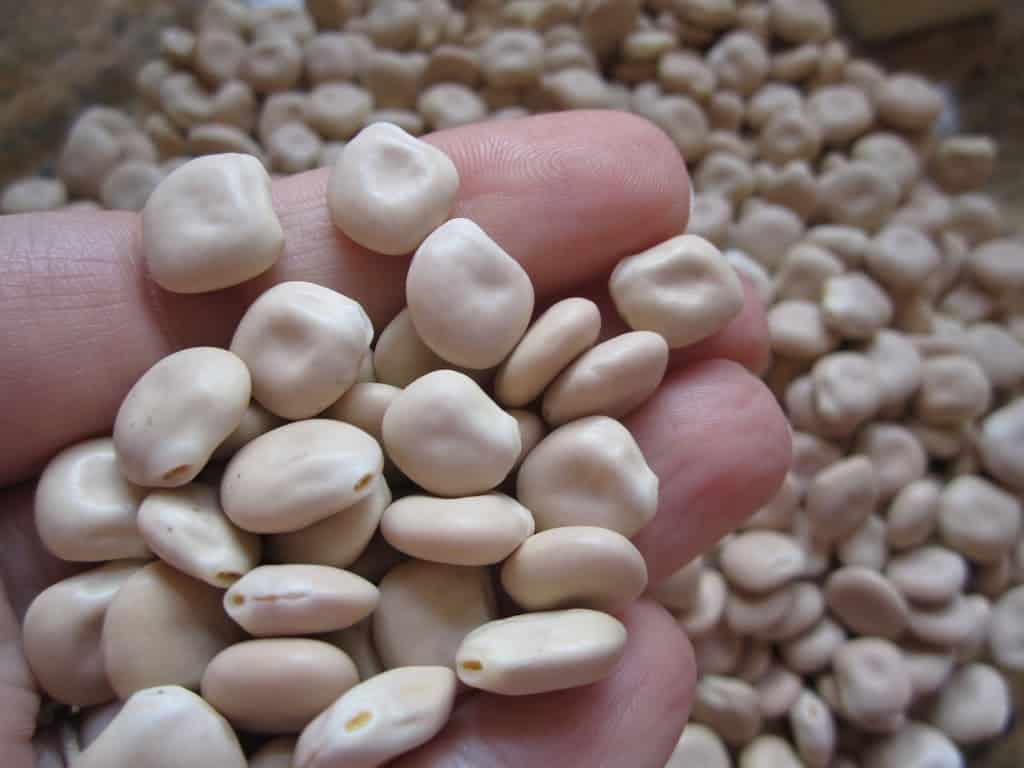
Lupini are a very unique type of bean which are popular in Italy, especially at Christmastime.
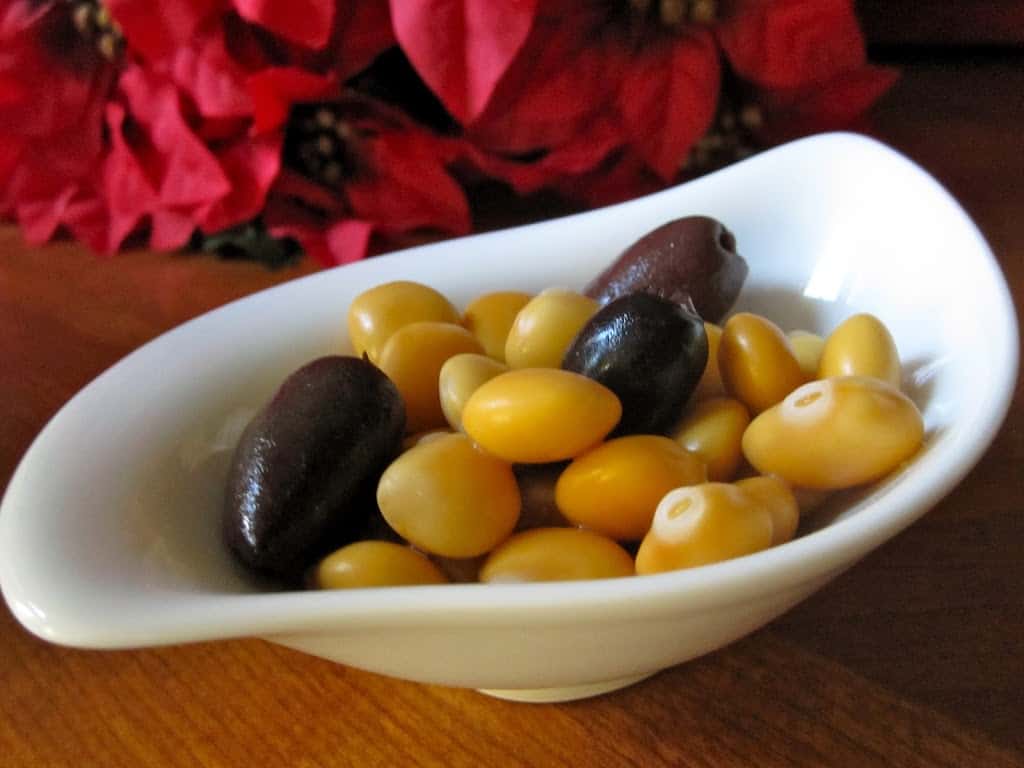
Lupini beans are also common in Spain where they are known as altramuces, and Portugal as tremoços. They do not have the taste or texture of any other bean I’ve ever had, and they also eaten differently (see below). Lupini beans are extremely bitter before being prepared, and must be soaked overnight, cooked the next day, then rinsed several times a day for the next 5 or 6 days.
Lupini are not the same as other beans which can be cooked and ready to eat right away.
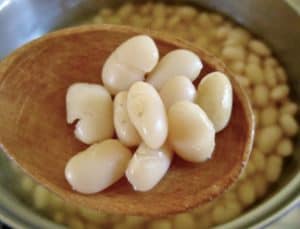
I’ve always wondered who the person was who discovered that if you just keep rinsing these beans that they would actually taste delicious, let alone edible! I can tell you, it’s no one that would get any sort of patent as lupini were eaten by ancient Egyptians! Please don’t let the process dissuade you as the end result is well worth it!
Interesting Fact: Have you ever seen lupin flowers? They are related to lupini beans.

You can just eat lupini beans as a healthy snack, antipasto or also after a meal, as they do in Italy.
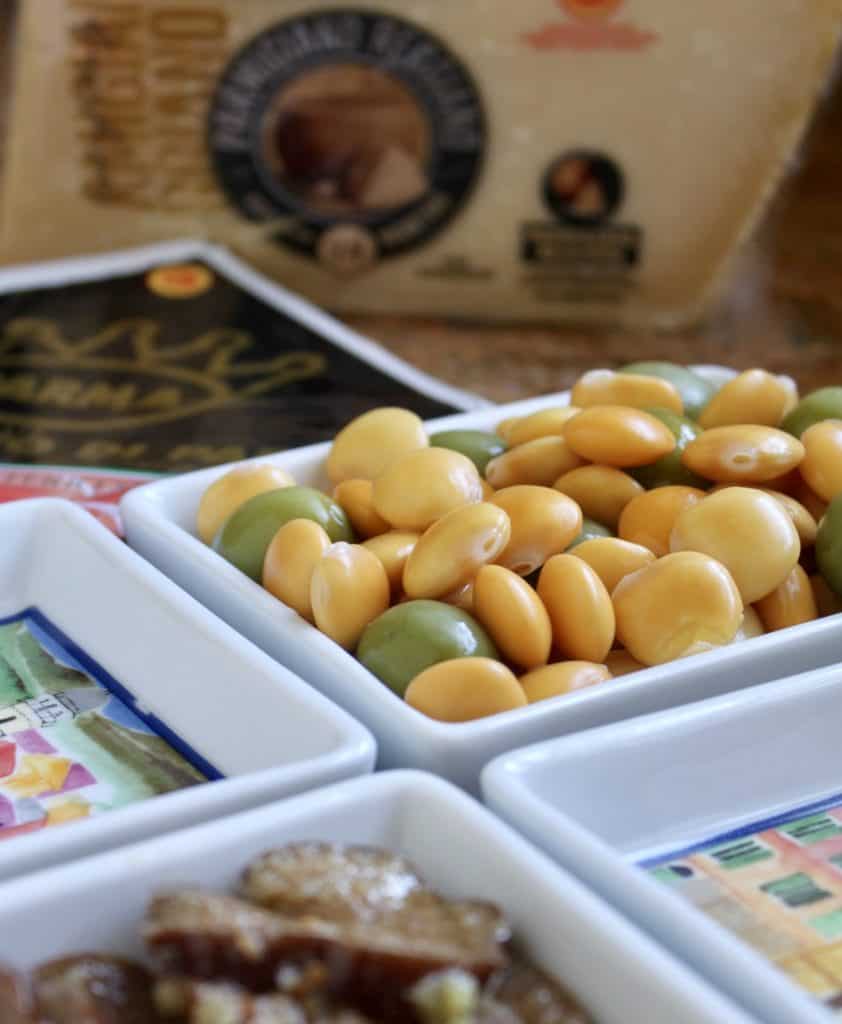
With an Italian style preparation, olives are mixed with the lupini at the end of the process, which lend their salty flavor to the beans. It’s a fabulous combination. You can find lupini beans at most Italian markets/delis and middle eastern shops. If you want a large bag of them, on (I would absolutely buy the 3 lb bag on Amazon and make them three different times).
I repeat: don’t let the process of making these intimidate you because there’s really nothing to it. The only caveat is remembering to start about six days before you want to eat them.
If you can boil beans and rinse them, you can prepare lupini.
Of course, these are great to eat as a snack because they’re so healthy and nutritious. Don’t just limit them to the Christmas season, you can eat them year-round. I will warn you though, once you start eating lupini, it’s very difficult to stop; they are very addictive.
*WARNING: Peanut allergy sufferers, please make sure you are not also allergic to lupini beans.
How to Cook Lupini Beans
my family recipe makes 20 servings
FULL PRINTABLE RECIPE BELOW
Ingredients
- one bag of dry lupini beans, look for beans without blemishes (I used one 14 oz bag)
- salt
- olives, green (like these, with pits are traditionally used in Italy) or black, with the liquid
Rinse and sort (take out any bad looking beans) the lupini, then soak them overnight, a minimum of 12 hours. Make sure to put a few inches of water above the beans so they don’t dry out when you’re trying to rehydrate them.

Cook the beans
Rinse the beans, then put them into a large pot with fresh water, covering the beans with at least a couple inches of water above them.
Bring to a boil, then reduce heat and simmer for 45-50 minutes, occasionally stirring with a wooden spoon.
Remove from heat, drain, and place into a large bowl and fill to cover with water.
Rinse the beans for about 5 days
At this point, just keep rinsing the lupini for about 30 seconds at a time, 3 to 4 times a day, for about 5 days (fewer, if you change the water more often.)
The bowl can be kept on the counter; it does not need to be refrigerated.
I kept track of how many times I changed the water over 5 days, and the total count was 18. Yes, this is necessary or you will have bitter beans. Note: do not eat bitter beans, they must lose all their bitter flavor before ingesting them.
At the end of the fifth day, taste a bean, or part of one, to check for bitterness. The bean will not taste good/sweet yet, but you are only checking for bitterness, nothing else. If the lupini beans are still bitter, continue to change the water until they are no longer bitter.
Add salt and olives
Next in the process is to add some salt (about one teaspoon of Kosher salt) to the lupini in the water (do not drain the beans after this). You can also add a can of black or green olives, liquid and all (not under oil). Stir well and taste after about three hours. If it needs more salt, add some. If you make the lupini too salty, just add a little more water.
DO NOT CHANGE THE WATER AFTER THIS and refrigerate, once the salt has been added.
Now the lupini are ready to eat! Use a mini sieve or slotted spoon to put some lupini and olives into a serving bowl, keeping the main bowl in the fridge. The lupini must be kept in water in the fridge, but are best served at room temperature.
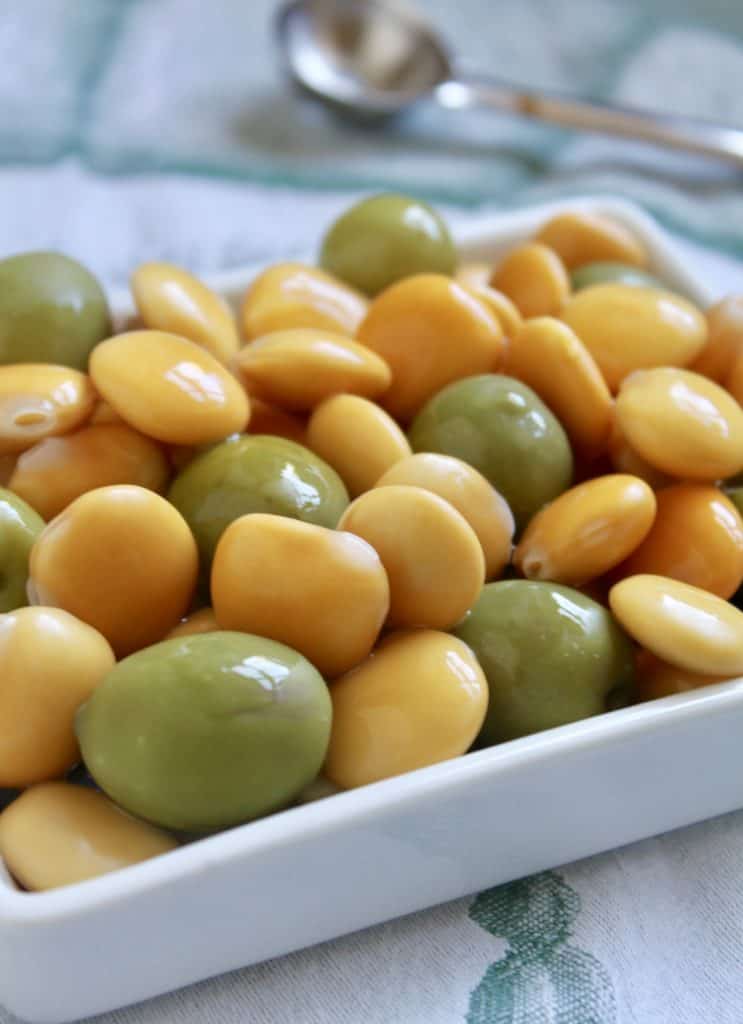
How to Eat Lupini Beans
There are three steps. Once you get the hang of it, you’ll be able to put away a dozen in under 15 seconds (don’t ask me how I know this). 🤔
- Take a lupini bean in your fingers and bite part way through the top part of the bean (where the little white part is) to break open the skin, but don’t bite the bean inside.
- Now, just squeeze gently while holding the bean in front of your mouth, and POP the bean in! I told you lupini were cooked and eaten differently than any other bean. 😁
- Discard the skin.
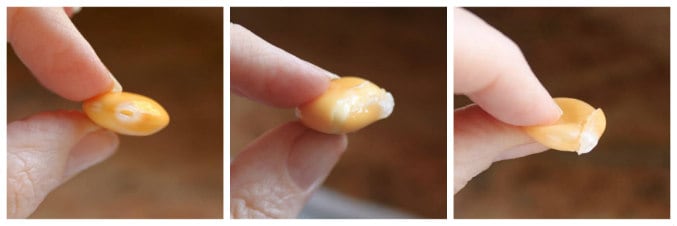
Can You Eat the Skin of a Lupini Bean?
Yes, the skin is edible. I can tell you that my brother and son just pop the whole bean into their mouths. However, I don’t like the texture of the skins, so I don’t eat them.
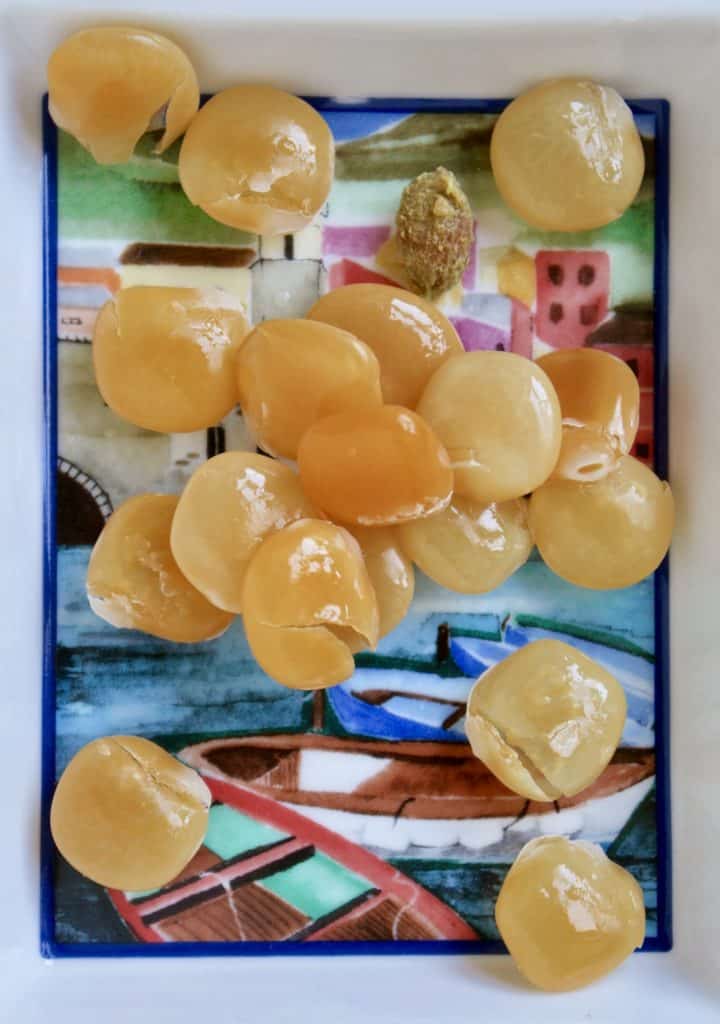
Once you get started, you won’t be able to stop, but remember, they are beans, so you probably don’t want to eat too many in one sitting. Now you know how to cook and eat lupini beans. Enjoy!
Interested in other authentic Italian dishes for Christmas Eve and Christmas Day?

Check out my Gift Guide and Product Recommendation List on Amazon!
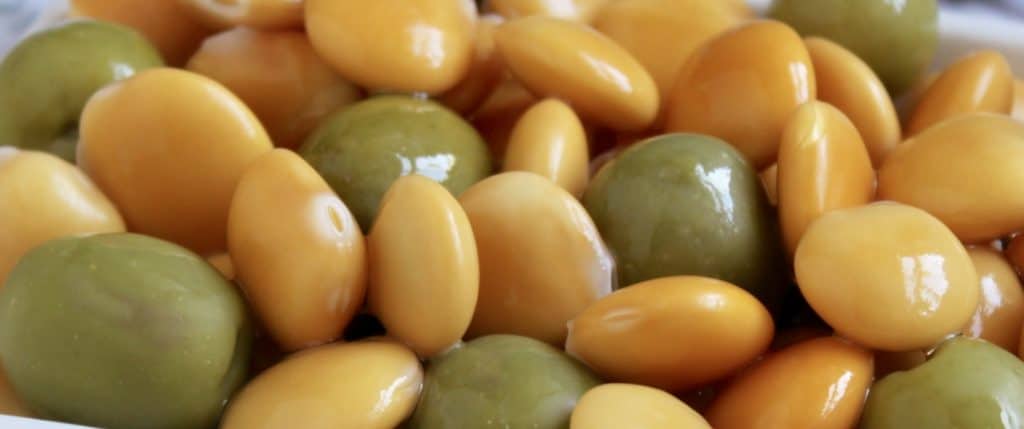
Don’t miss another post! Sign up for my free subscription for recipes and travel.

Lupini Beans and Olives, An Italian Christmas Tradition (How to Cook & Eat Lupini)
Ingredients
- 14 oz lupini beans dried beans (look for beans without blemishes)
- 1 Tbsp salt Kosher or sea salt
- 20 oz olives green (like Castelvetrano, with pits are traditionally used in Italy) or black olives, with the liquid
Instructions
- Rinse and sort (take out any bad looking beans) the lupini, then soak them overnight, a minimum of 12 hours. Make sure to put a few inches of water above the beans so they don't dry out when you're trying to rehydrate them.
- Rinse the beans, then put them into a large pot with fresh water, covering the beans with at least a couple inches of water above them.
- Bring to a boil, then reduce heat and simmer for 45-50 minutes, occasionally stirring with a wooden spoon.
- Remove from heat, drain, and place into a large bowl and fill to cover with water.
- At this point, just keep rinsing the lupini for about 30 seconds at a time, 3 to 4 times a day, for about 5 days (fewer, if you change the water more often.)
- The bowl can be kept on the counter; it does not need to be refrigerated.
- I kept track of how many times I changed the water over 5 days, and the total count was 18. Yes, this is necessary or you will have bitter beans.
- At the end of the fifth day, taste a bean, or part of one, to check for bitterness. The bean will not taste good/sweet yet, but you are only checking for bitterness, nothing else. If the lupini beans are still bitter, continue to change the water until they are no longer bitter.
- Next in the process is to add some salt, probably about one teaspoon of Kosher salt to the lupini in the water (do not drain the beans after this.) You can also add a can of green (this is the Italian style) or black olives, liquid and all (not under oil). Stir well and taste after about three hours. If it needs more salt, add some. If you make the lupini too salty, just add a little more water.
- DO NOT CHANGE THE WATER ANYMORE and refrigerate, once the salt has been added.
- Now the lupini are ready to eat! Use a mini sieve or slotted spoon to put some lupini and olives into a serving bowl.
Notes
- Nutrition info is just for the lupini.
- Lupini can be kept in salted water in the fridge for up to 2 weeks (without olives.)
Nutrition
Christina’s Cucina is a participant in the Amazon Services LLC Associates Program, an affiliate advertising program designed to provide a means for sites to earn advertising fees by advertising and linking to Amazon.com.




I see some recipes say to boil for only 15 minutes because they will turn to mush. The ones in the jars (Cotas), seem almost raw. I will be trying to make them myself and use your recipe. Thoughts?
Wow, 15 minutes for beans? I’ve never boiled any beans for only 15 minutes and had them be cooked.
I actually have some lupini soaking right now and can’t even tell you how many times I’ve made them and NEVER had them turn to mush. Here’s the thing, Barbara, a lot of bloggers out there see a recipe and put it on their site, having made that recipe once. They have no history with the recipe, no experience, yet come across as an authority. It’s frustrating for people like me because we see that people who don’t know being confused by the misinformation that is being shared.
For example, I just saw an Eton Mess recipe described as a trifle this morning. It is NOT a trifle, but someone who has never heard of Eton Mess will now continue their life thinking it is a trifle :( Sorry I’m writing so much, but what I’m trying to say is that if you follow my directions, your lupini will be cooked thoroughly (not overcooked or mush) and will taste really good in the end! :) This is the way my Nonna, all my aunts, my mother and me have always made them (they were all born in Italy and know their food). Let me know how they turn out for you! Christina
I made this in a large batch, since I never had the beans before and they were in a donation.
Love them but I have ran into a problem.
How to store ? If I put them in the frig I get the usual problem with olive oil when it gets cold.
Answers please
Hi William, just put them in the fridge in the water they are seasoned in (with salt). They will keep for about a week in the fridge this way. No oil, please. :)
As a small child I remember my grandma preparing food, she had a pantry lined with shelves of her preserved veggies. Ruby red tomatoes with green basil leaves, crooked string beans, speckled red and green, roasted peppers, marinated eggplant and my fathers favorite lupine beans. Whenever o smell basil, or see those jeweled colors i transported back in time to those happy times.
Just made them ! I added vinaigre, salt, garlic ( lots of it) and olive oil..
It is awsome !
It took me a couple more days to get the beans ready, because I forgot them ..lol
Yes, it varies depending on how often you rinse them, but so glad you liked the end result!! Thanks for letting me know!
I am a little late in making my comment but only today came across your web page. In Australia we have the sweet Angustifolia lupin bean ( sweet lupins) and they do not require any soaking – being low in alkaloids it is safe to ccok. A quick soak if you wish perhaps then cook. Just thought I would add my comment. Looking at all the comments I am considering looking at exporting. We produce 80% of the worlds lupins here, mostly sweet. Cheers.
Wow! That’s amazing, as I’ve never heard of sweet lupins! So if I understand correctly, they aren’t truly “sweet” just not bitter like the ones we get, so they taste the same as ours just require no constant rinsing? I hate all the water it takes to make them because we’re in a horrific drought. Let me know if you do export them, thank you, Ian!
My story is a little different. First, I buy them already prepared in a bottle. They are good. But, the rest of the story, : when I was very small, 2 0r 3 and lived in North Eastern Pennsylvania, my Grandmother used to go to the church fair bingo and they used dried lupine beans for bingo covers. Today , I just bought a bottle to snack on. I was looking up the nutrition value when I came upon this website. Thanks for the info,
How cute is that!? Love it, thank you, Jan!
In my grandparent place..pickling spices were added after the long “rinse”/brine time. Classic…
That’s interesting, Rich.
Thanks for your recipe. I’ve been trying these for a couple of years and was not successful. I can’t wait to try your recipe
Works every time, Pat! Good luck!